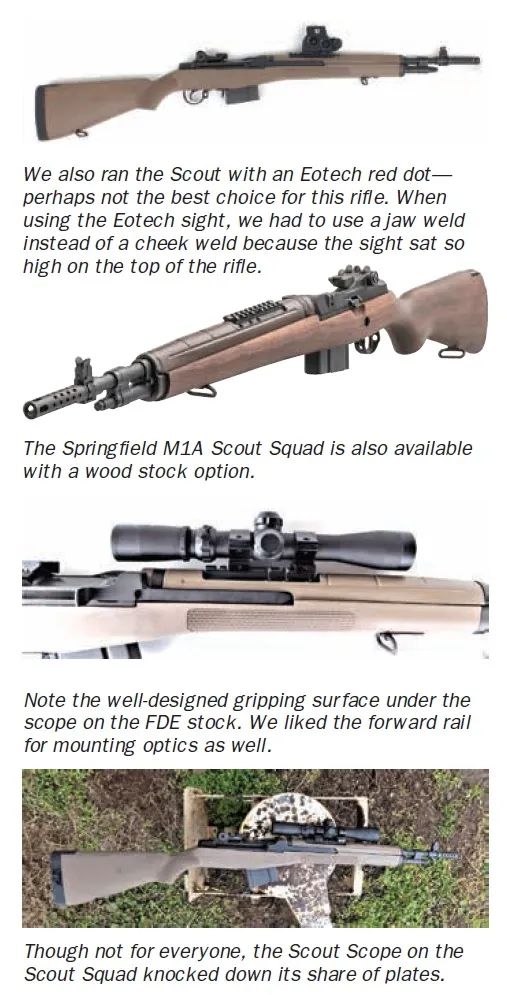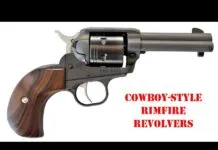GUN TESTS GRADE: A
$1455
his is a pre-virus price at BudsGunShop.com. Springfield M1A rifles once took us to the days of blued steel and walnut. Today, the majority of M1A rifles wear synthetic stocks, like this one, that will not warp and which offer good factory bedding. Springfield no longer lists this AA9120 FDE synthetic-stock version on its website, and most retailers show it as out of stock. Not to worry: The AA9126 is a black-synthetic version that is comparable to our test gun in everything except color. The AA9122 is a wood-stock version of the Scout Squad.
| Action | Gas-operated semi-automatic |
| Overall Length | 37.5 in. |
| Overall Height | 4.75 in. |
| Maximum Width | 4.75 in. |
| Weight Unloaded | 8.0 lbs. |
| Capacity | 8 |
| Barrel | 18.0 in. |
| Trigger Style | Two-stage military |
| Trigger Weight | 6.75 lbs. |
| Buttstock | Wood |
| Fore-end | Wood |
| Magazine | En bloc clip |
| Magazine Release | Manual |
| Bolt Release | Manual |
| Rear Sight | Aperture |
| Front Sight | Blade |
| Receiver Scope Provisions | None |
| Warranty | None |
| Telephone | NA |
| Website | NA |
| Made In | USA |
 The M1A features a trigger-guard-mounted safety that is pressed forward to fire. Some of the raters used the thumb to move the safety because these are often quite stiff. We didn’t feel much difference in pressure needed to operate the safeties. At this point, we should mention these rifles have a free-floating firing pin. Never allow the bolt to slam home on a loaded chamber. The firing pin may take a run and ignite the cartridge. Always insert a loaded magazine, rock it into place, and then either release the bolt or rack the bolt to let it run forward. This slows the bolt down as it properly loads a cartridge from the magazine. The Garand is the same type of action and should also be loaded only from the magazine, not single loaded. The 18-inch-barrel M1A is a bold move for Springfield that has been well received since its introduction. After all, the M1A enjoys a great reputation for reliability and accuracy, and the short rifle is a different type of firearm for a different niche. The rifle was tested with a total of four different loads. The majority load used was fired during the combat and tactical course. This was the Winchester 147-grain full metal jacket. We also used Fiocchi’s 150-grain SST as an example of a hunting load. The Hornady Black 168-grain A-Max is a good example of a tactical round. As an example of a match load, we used the Black Hills Ammunition 175-grain round. We used the Winchester FMJ load in combat shooting, firing 100 cartridges in each rifle. The JSP loads were fired for accuracy from the bench rest. We also fired a full magazine of the Fiocchi 150-grain SST offhand. To start, we lubricated the bolt and critical areas and loaded five magazines with Winchester FMJs. We fired the rifle at human silhouette targets at 25, 50, and 100 yards, as well as a steel reaction plate at 100 yards. We found the rifle comes to the shoulder quickly and moves quickly to cover targets. Recoil is there with the 308 round, but the gas-operated rifle generates less felt recoil than similar-weight bolt-action rifles. The rifle offered a rapid follow-up shot. It wasn’t difficult to fill the target full of holes quickly at 25 yards. At 50 yards, we slowed down a little, and at 100 yards, firing a 5- to 8-inch offhand group takes time, attention to the trigger press, and a good sight picture. But the rifle would do it if we did our part. At one point, we fitted the rifle with a Leatherwood Hi Lux Scout Scope. This isn’t an expensive unit ($140 at Brownells.com), but the rater using it has enjoyed good service with the optic. This 2×7-32mm scope has a long eye relief like a pistol scope. While we found it useful, it should be used only at the lowest resolution in snap shooting or fast shooting. An advantage is that the Scout Scope may be used with both eyes open at the lowest setting. After some acclimation, we found the Hi Lux Scout Scope could be fast at 50 yards or so, but some of the raters preferred iron sights. Most of the shooting was done with iron sights. However, firing off the benchrest, we found that groups could be improved using the highest setting on the Leatherwood Hi Lux. It just takes getting used to. We also briefly mounted an Eotech red dot. This sight is a good performer, but with the M1A demands a chin weld rather than a cheek weld when using this type of sight, not ideal for most shooters. We started by firing 100 rounds of Winchester FMJs and 20 rounds of Fiocchi jacketed soft points. There were no failures to feed, chamber, fire, or eject. Firing at the steel reaction targets at 100 yards, we seldom missed. The sights offer 1-minute-of-angle movement per click, and the front post offered good visibility, although it would subtend a very small target at 100 yards. In firing for accuracy, we used the Black Hills, Fiocchi, and Hornady JSP loads. Shot from a solid benchrest with iron sights, the rifle exhibited good accuracy for a short-barrel 308 self loader. The various loads averaged 2.0 inches, and consistent. Our Team Said: There wasn’t really anything we did not like about this rifle. We liked the SOCOM more, however. Written and photographed by Gun Tests Staff, using evaluations from Gun Tests team testers.
The M1A features a trigger-guard-mounted safety that is pressed forward to fire. Some of the raters used the thumb to move the safety because these are often quite stiff. We didn’t feel much difference in pressure needed to operate the safeties. At this point, we should mention these rifles have a free-floating firing pin. Never allow the bolt to slam home on a loaded chamber. The firing pin may take a run and ignite the cartridge. Always insert a loaded magazine, rock it into place, and then either release the bolt or rack the bolt to let it run forward. This slows the bolt down as it properly loads a cartridge from the magazine. The Garand is the same type of action and should also be loaded only from the magazine, not single loaded. The 18-inch-barrel M1A is a bold move for Springfield that has been well received since its introduction. After all, the M1A enjoys a great reputation for reliability and accuracy, and the short rifle is a different type of firearm for a different niche. The rifle was tested with a total of four different loads. The majority load used was fired during the combat and tactical course. This was the Winchester 147-grain full metal jacket. We also used Fiocchi’s 150-grain SST as an example of a hunting load. The Hornady Black 168-grain A-Max is a good example of a tactical round. As an example of a match load, we used the Black Hills Ammunition 175-grain round. We used the Winchester FMJ load in combat shooting, firing 100 cartridges in each rifle. The JSP loads were fired for accuracy from the bench rest. We also fired a full magazine of the Fiocchi 150-grain SST offhand. To start, we lubricated the bolt and critical areas and loaded five magazines with Winchester FMJs. We fired the rifle at human silhouette targets at 25, 50, and 100 yards, as well as a steel reaction plate at 100 yards. We found the rifle comes to the shoulder quickly and moves quickly to cover targets. Recoil is there with the 308 round, but the gas-operated rifle generates less felt recoil than similar-weight bolt-action rifles. The rifle offered a rapid follow-up shot. It wasn’t difficult to fill the target full of holes quickly at 25 yards. At 50 yards, we slowed down a little, and at 100 yards, firing a 5- to 8-inch offhand group takes time, attention to the trigger press, and a good sight picture. But the rifle would do it if we did our part. At one point, we fitted the rifle with a Leatherwood Hi Lux Scout Scope. This isn’t an expensive unit ($140 at Brownells.com), but the rater using it has enjoyed good service with the optic. This 2×7-32mm scope has a long eye relief like a pistol scope. While we found it useful, it should be used only at the lowest resolution in snap shooting or fast shooting. An advantage is that the Scout Scope may be used with both eyes open at the lowest setting. After some acclimation, we found the Hi Lux Scout Scope could be fast at 50 yards or so, but some of the raters preferred iron sights. Most of the shooting was done with iron sights. However, firing off the benchrest, we found that groups could be improved using the highest setting on the Leatherwood Hi Lux. It just takes getting used to. We also briefly mounted an Eotech red dot. This sight is a good performer, but with the M1A demands a chin weld rather than a cheek weld when using this type of sight, not ideal for most shooters. We started by firing 100 rounds of Winchester FMJs and 20 rounds of Fiocchi jacketed soft points. There were no failures to feed, chamber, fire, or eject. Firing at the steel reaction targets at 100 yards, we seldom missed. The sights offer 1-minute-of-angle movement per click, and the front post offered good visibility, although it would subtend a very small target at 100 yards. In firing for accuracy, we used the Black Hills, Fiocchi, and Hornady JSP loads. Shot from a solid benchrest with iron sights, the rifle exhibited good accuracy for a short-barrel 308 self loader. The various loads averaged 2.0 inches, and consistent. Our Team Said: There wasn’t really anything we did not like about this rifle. We liked the SOCOM more, however. Written and photographed by Gun Tests Staff, using evaluations from Gun Tests team testers.



























